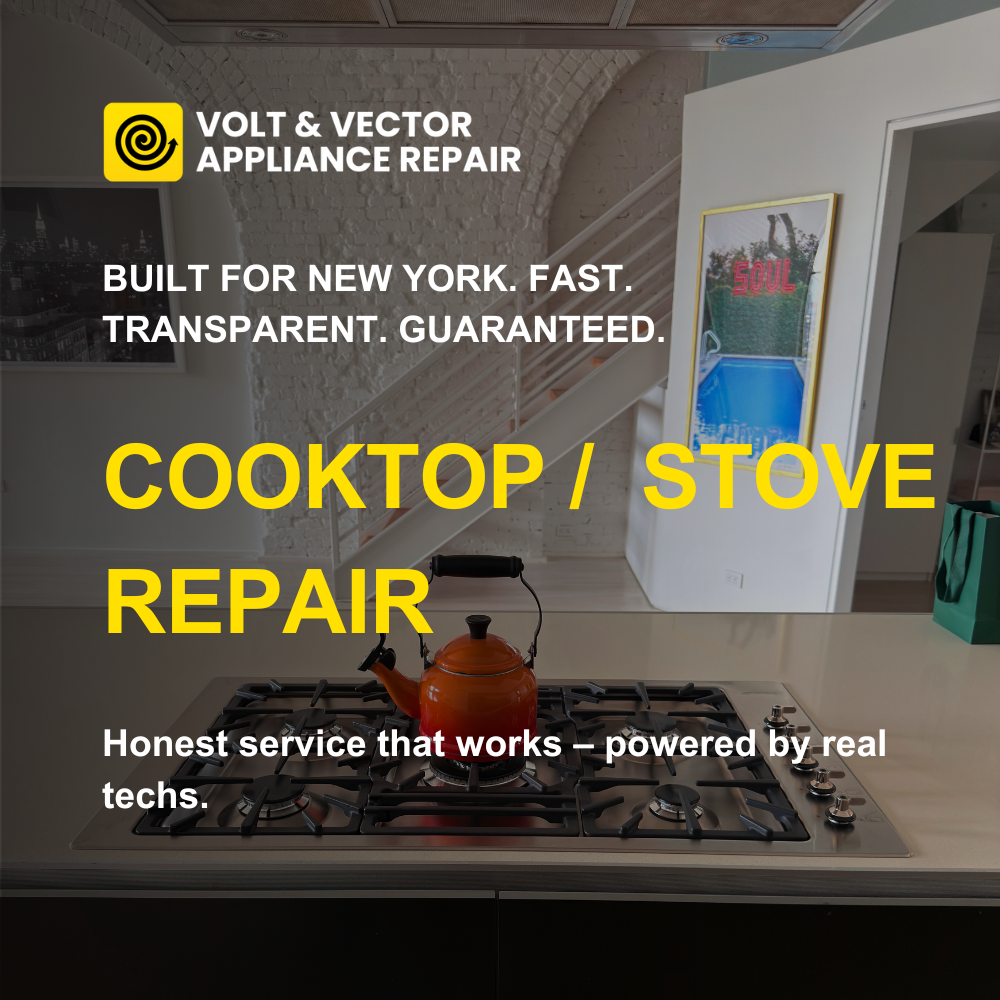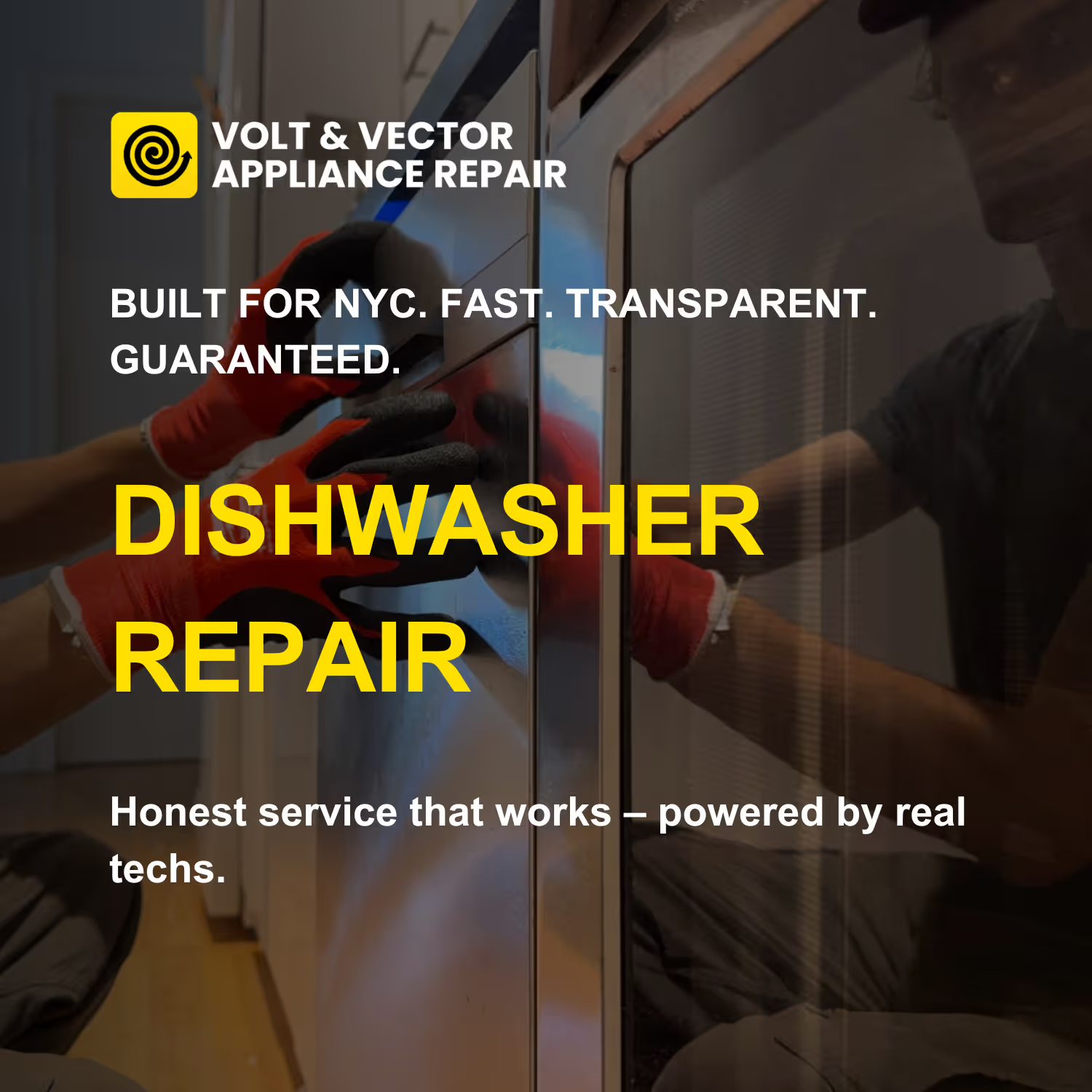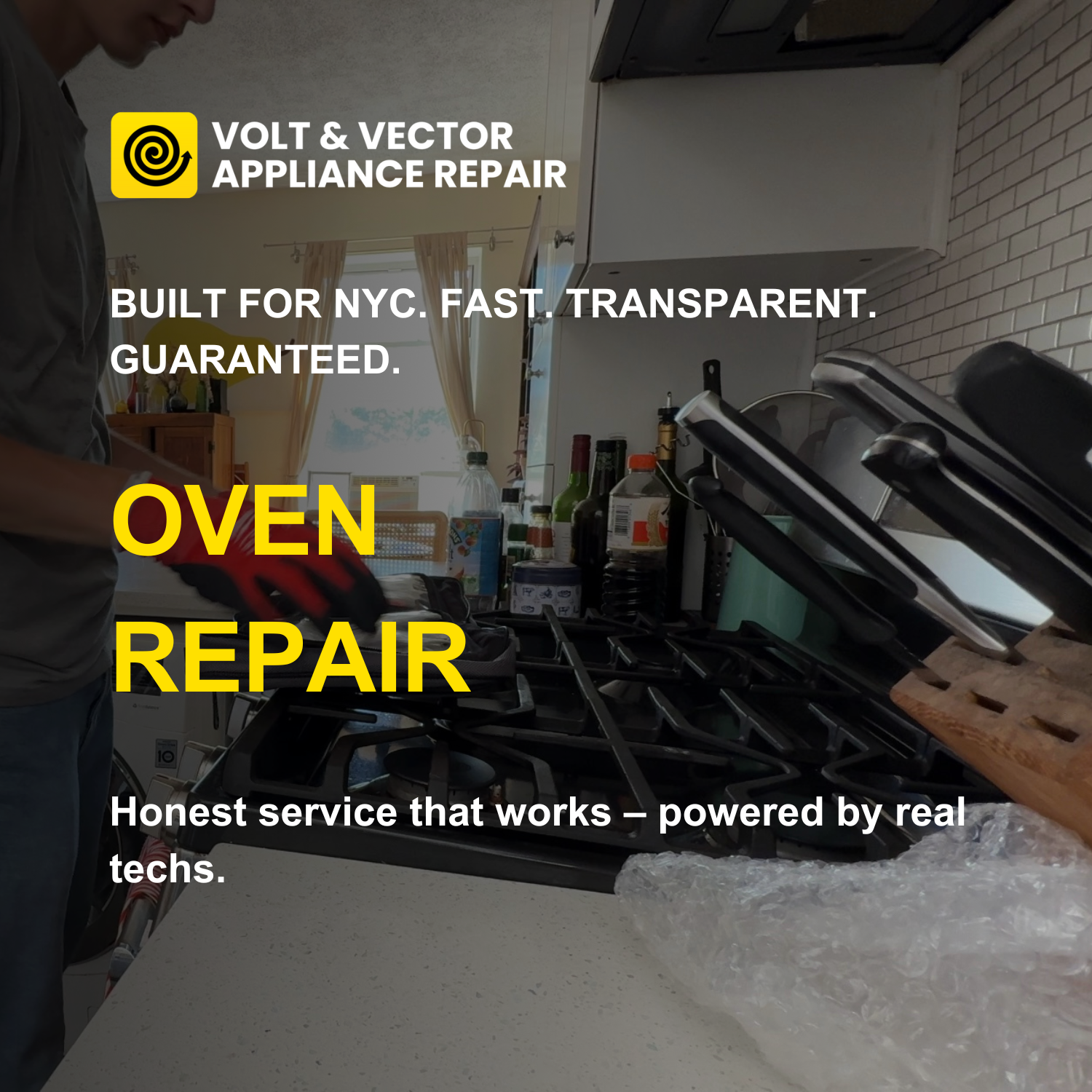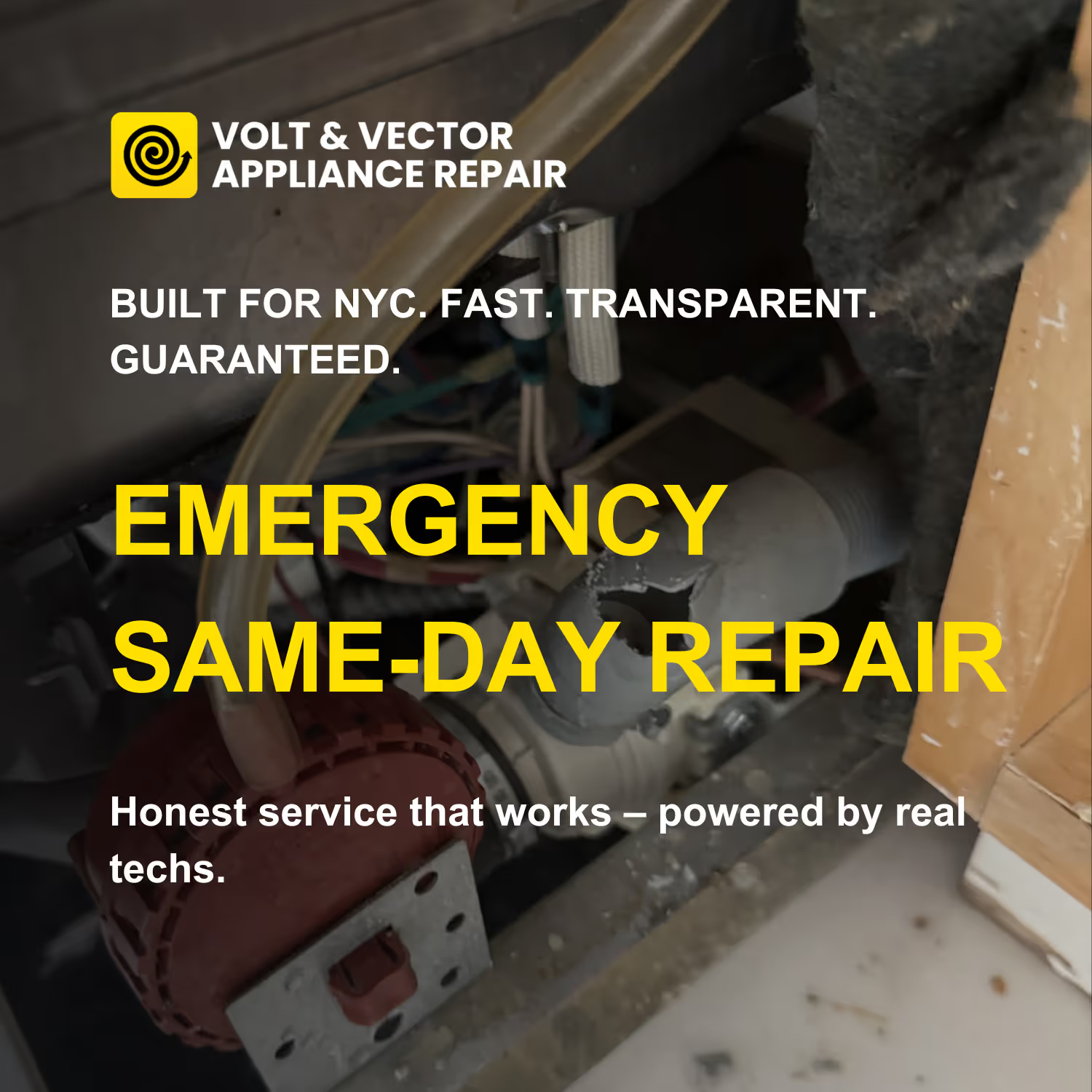Professional Stove / Oven / Cooktop Repair in NYC
Volt & Vector Appliance Repair
24 Google reviews
Volt & Vector is a licensed and insured appliance-repair company based in Downtown Brooklyn and serving Brooklyn and Manhattan (below 96th Street). We offer same-day or next-day service, use OEM parts only, and stand behind every job with a 180-day parts & labor warranty.
Local techs:
+1 (332) 333-1709
.avif)
About Us
About Us & How It Works
1. Schedule your visit
2. On-site diagnostic
3. Approve & repair
4. Done & covered
COI (Certificate of Insurance)
COI available on request for buildings that require it (common in Manhattan condos/co-ops; less common in Brooklyn and Queens walk-ups). We can only issue COIs that match our actual policy. If your building asks for limits or endorsements outside our coverage, we cannot modify the policy or issue a non-compliant COI. In those cases, we’ll tell you immediately so you don’t lose time and can choose a contractor whose insurance matches your building’s requirements. Many service calls do not require a COI; your building or management office can confirm what they need.
Also keep in mind: sometimes the issue is not a failed part but an installation problem or incorrect use (for example, blocked vents, overloaded washers, or wrong panel clearances). Our technicians will point that out and show you how to prevent the same problem in the future.
Warranty & Compliance
180-day warranty on both parts and labor for completed repairs. All parts are factory-original OEM, sourced through authorized distributors. For older appliances, it’s normal for surrounding components to start showing their age. One repair can expose another weak part. When that happens, we don’t just “stack” charges - we explain what changed, what failed, and your options before doing any extra work. Work is performed in line with applicable NYC electrical, gas, and plumbing safety requirements. Documentation is stored securely so we can reference past visits.
Safety & Courtesy Protocol
We treat every visit like we’re guests in your home: Technicians wear shoe covers or remove footwear when requested. We protect floors and surrounding surfaces where tools or panels are used. We clean up our work area when the job is done. If you ever notice dust or a small mess left behind, that’s on us — each tech handles multiple calls per day, but that’s not an excuse. Tell us and we’ll make it right.
Timing & communication: If your window is 11–1, the tech will usually aim to arrive closer to the start of that window when routing allows. You’ll typically receive a text alert ~30 minutes before arrival. If we’re running late or a prior job explodes into something bigger (premium built-ins love surprises), we’ll text you as soon as we know.
Goal: work clean, stay safe, respect your space and your time.
Coverage
We focus on dense NYC neighborhoods where premium built-in appliances are common and access is realistic for same-day or next-day service.
Brooklyn (core neighborhoods)
Brooklyn Heights, DUMBO, Downtown Brooklyn, Fort Greene, Clinton Hill, Boerum Hill, Cobble Hill, Carroll Gardens, Park Slope, South Slope, Windsor Terrace, Kensington, Prospect Heights, Prospect Lefferts Gardens, Greenwood Heights, Gowanus, Greenpoint, Bedford–Stuyvesant, Crown Heights, and nearby covered ZIPs.
Queens (selected ZIP codes)
Middle Village, Rego Park, Forest Hills, Fresh Meadows, Whitestone, North/Broadway Flushing, College Point and surrounding blocks within ZIPs 11354, 11356, 11357, 11365, 11374, 11375, 11379.
Manhattan (below 96th Street)
FiDi, Battery Park, Tribeca, SoHo, Greenwich Village, East Village, Chelsea, Gramercy, Midtown East/West, Upper East Side, Upper West Side, and surrounding neighborhoods south of 96th Street.
Westchester County (Pilot Coverage)
White Plains, NY (10601–10606)
High-end appliance repair for condos, co-ops, and single-family homes in central White Plains.
Same diagnostic workflow, OEM parts, and 180-day warranty.
COI available for building management; arrival windows coordinated based on local traffic patterns.
For exact availability by address, use our ZIP checker or share your ZIP + cross streets when booking.
Why Volt & Vector
We’ve spent years working inside large NYC repair companies - seeing how real technicians get buried under rushed schedules, fake “same-day” promises, and endless call-center noise. Volt & Vector grew out of that frustration. We wanted a place where diagnostics still matter, where techs can take time to do the job right and talk to people directly. We’re not calling ourselves perfect - far from it - but we’re building the kind of service we always wanted to work for: respectful, transparent, and run by people who actually fix things.
Pricing & Diagnostic Policy
The $99 diagnostic visit is always billed at the first appointment. That’s the starting point for every job.After the visit, the technician sends notes, photos, and test results to our service desk. Sometimes the tech can give a ballpark range on-site, but we’re moving away from instant “off-the-cuff” quotes — OEM parts pricing moves fast, and we prefer accuracy over guessing.
Simple issues
Things like a clogged filter, loose connection, minor reset or simple adjustment can often be fixed on the spot, starting from $99 (diagnostic-only level) if no extra parts or extended labor are needed.
Repairs with parts
We’d rather be blunt than vague: NYC appliance repair is not cheap, especially on Sub-Zero, Miele, Viking, Wolf, Fisher & Paykel, and Bosch.
Our promise is not “lowest price” - it’s clear diagnostics, OEM parts, and no surprises: You see the diagnostic results and estimate before any repair begins. The $99 diagnostic is credited when you proceed with that repair. If a job doesn’t make financial sense (age, condition, part cost), we say that out loud and walk you through options.
About Stove Repair in NYC
What We Actually Do
Our approach: Observe → Hypothesize → Test → Fix → Verify. That’s how we prevent guesswork, damage, and repeat visits.
- Observation. Quick heat test; check ignition/spark, flame stability, time-to-temperature, bake/broil elements, convection fan, door hinges/gasket, power/breaker, terminal block and wiring. For gas: basic safety checks and visual flame assessment.
- Hypothesis. Map symptoms to fuel type and design: gas (hot-surface igniter, spark module, gas valve), electric (bake/broil element, temp sensor, relays), induction (power module, cooling, sensors), plus brand/format differences (slide-in, freestanding, wall oven).
- Test. Measure time to 350°F (175°C); compare sensor reading to setpoint; check element continuity and current draw; verify fan operation; confirm control response; assess flame color/stability; confirm correct gas supply/voltage.
- Fix. Open only what’s needed: replace/adjust igniter or spark module, bake/broil elements, temperature sensor, convection fan; clean burner heads and orifices; correct door hinges and gasket; calibrate temperature; tidy/secure terminal connections.
- Verify. Proof run: setpoint reached quickly and held steady; flame clean and even; convection quiet; burners move from simmer to high without drop-outs; no error codes.
Result: accurate heat and even baking, safe fast ignition, quieter operation, no leaks or fault codes.
Brand-Specific Guidance (What Usually Works by Design)
We service Wolf, Viking, Thermador, La Cornue, Miele, Gaggenau, Bertazzoni, JennAir, Monogram, ILVE, KitchenAid, GE, Whirlpool, Maytag, Café, Samsung, LG, Bosch, Frigidaire, Amana, and more. Designs age differently, so we check what matters for each.
Wolf / Viking / Thermador — pro ranges
Typical behavior: powerful burners and convection; hot-surface igniters are a common wear item; weak spark can “tick” without lighting.
When you notice: long preheats, can’t hold temperature, burner clicks but won’t light.
We usually find: aging igniter, dirty burner ports, tired spark module.
We do: new igniter/module, burner cleaning/air mix adjustment, oven temperature calibration.
We confirm: fast rise to setpoint and stable convection.
Samsung / LG — sensor-driven, glass-top & induction
Typical behavior: control logic stretches cycles when readings aren’t clean.
When you notice: slow preheat, self-clean or panel errors, uneven bake.
We usually find: drifted temp sensor, weak element/relay; for induction—hot power module or cooling issue.
We do: sensor/element/relay replacement, clean/restore cooling path, power-module service if needed.
We confirm: normal preheat time and steady cycle.
GE / Whirlpool / Maytag / KitchenAid — robust U.S. platforms
Typical behavior: sturdy elements and terminal blocks; weak points are bake elements, overheated terminals, and door gaskets.
When you notice: top/bottom browning uneven, faint burnt-plastic smell near the back, temperature “wanders.”
We usually find: open bake/broil element, scorched terminals, tired door gasket.
We do: new elements/terminals/gasket, calibration.
We confirm: even sheet-pan test and no odors.
Miele / Gaggenau / La Cornue / Bertazzoni / Monogram — premium & designer
Typical behavior: sophisticated electronics/cooling and precise door mechanics.
When you notice: cooling fan noisy/not running, door alignment feels off, lock error after self-clean.
We usually find: cooling fan or sensors, door adjustment, lock/actuator wear.
We do: fan/sensor replacement, door alignment/lock service, settings updates where supported.
We confirm: quiet airflow, correct lock/unlock, smooth temperature curve.
ZIP coverage — Brooklyn, Manhattan & select Queens
Use the ZIP code checker to see if we can come out to your building. If your ZIP is listed, we can usually offer same-day or next-day appliance repair, depending on parts and schedule. If your ZIP code is outside our current service area, you can still reach out — in some cases we may be able to help, or recommend a trusted partner nearby.
Primary Services
See the full catalog of our services—organized by brand and by appliance—right here.





.avif)
.avif)
.avif)
.avif)
